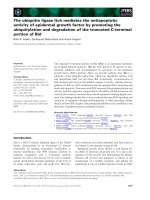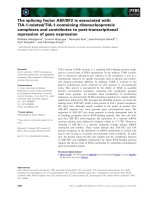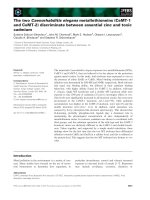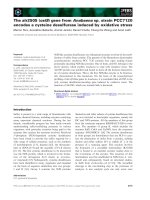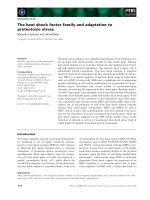Tài liệu Báo cáo khoa học: "The Summarization Integrated Development Environment" pptx
Bạn đang xem bản rút gọn của tài liệu. Xem và tải ngay bản đầy đủ của tài liệu tại đây (730.18 KB, 4 trang )
Proceedings of the ACL-08: HLT Demo Session (Companion Volume), pages 24–27,
Columbus, June 2008.
c
2008 Association for Computational Linguistics
SIDE: The Summarization Integrated Development Environment
Moonyoung Kang, Sourish Chaudhuri, Mahesh Joshi, Carolyn P. Rosé
Carnegie Mellon University
5000 Forbes Avenue
Pittsburgh, PA 15213 USA
moonyoun,schaudhu,maheshj,
Abstract
In this type-II demo, we introduce SIDE
1
(the
Summarization Integrated Development Envi-
ronment), an infrastructure that facilitates
construction of summaries tailored to the
needs of the user. It aims to address the issue
that there is no such thing as the perfect sum-
mary for all purposes. Rather, the quality of a
summary is subjective, task dependent, and
possibly specific to a user. The SIDE frame-
work allows users flexibility in determining
what they find more useful in a summary,
both in terms of structure and content. As an
educational tool, it has been successfully user
tested by a class of 21 students in a graduate
course on Summarization and Personal Infor-
mation Management.
1 Introduction
A wide range of summarization systems have
been developed in the past 40 years, beginning
with early work in the Library sciences field. To
this day, a great deal of research in summarization
focuses on alternative methods for selecting sub-
sets of text segments based on a variety of forms of
rhetorical analysis and relevance rankings. Never-
theless, while there is much in common between
approaches used for summarization in a variety of
contexts, each new summarization project tends to
include a new system development effort, because
a general purpose, extensible framework for sum-
1
The working system can be downloaded from
and a video
of an example of SIDE use can be found at
This project is supported by ONR Cognitive and Neural
Sciences Division, Grant number N000140510043
marization has not been made available. As an ex-
ample, Teufel and Moens’ (2002) argue that the
summarization strategy for scientific articles must
be different from news articles because the former
focus on novelty of information, are much longer
and very different in structure.
A large proportion of summarization systems do
not allow users to intervene in the summarization
process so that the form of the summary could be
tailored to the individual user’s needs (Mieskes, M.,
Müller, C., & Strube, M., 2007). From the same
document, many summaries can potentially be
generated, and the most preferable one for one user
will not, in general, be the same as what is pre-
ferred by a different user. The fact that users with
similar backgrounds can have vastly differing in-
formation needs is highlighted by Paice and Jones’
(1993) study where an informal sentence selection
experiment had to be abandoned because the par-
ticipants, who were agriculture experts, were too
influenced by their research interests to agree with
each other. However, summarization systems tend
to appear as black boxes from the user’s perspec-
tive and the users cannot specify what they would
want in the summary.
SIDE is motivated by the two scenarios men-
tioned above - the absence of a common tool for
generating summaries from different contexts, as
well as the fact that different users might have dif-
ferent information needs from the same document.
Bellotti (2005) discusses the problem of informa-
tion overload in communication media such as e-
mail and online discussion boards. The rapid
growth of weblogs, wikis and dedicated informa-
tion sources makes the problem of information
overload more acute. It also means that summari-
zation systems have the responsibility of taking
into account the kind of information that its user
would be interested in.
With SIDE, we attempt to give the user a greater
say in deciding what kind of information and how
much of it the user wants as part of his summary.
24
In the following sections, we elaborate on the
features of SIDE and its technical details.
2 Functionality
The design of SIDE is aimed at allowing the user
as much involvement at every stage of the sum-
mary generation process as the user wishes. SIDE
allows the user to select a set of documents to train
the system upon, and to decide what aspects of
input documents should be detected and used for
making choices, particularly at the stage of select-
ing a subset of segments to preserve from the
source documents. The other key feature of the
development environment is that it allows devel-
opers to plug in custom modules using the Plugin
Manager in the GUI. In this way, advanced users
can extend the capabilities of SIDE for meeting
their specific needs while still taking advantage of
the existing, general purpose aspects of SIDE.
The subsequent sub-sections discuss individual
parts of system behavior in greater detail at a con-
ceptual level. Screen shots and more step by step
discussion of how to use the GUI are given with
the case study that outlines the demo script.
2.1 Filters
To train the system and create a model, the user
has to define a filter. Defining a filter has 4 steps –
creating annotated files with user-defined annota-
tions, choosing feature sets to train (unigrams, bi-
grams etc), choosing evaluation metrics (Word
Token Counter, TF-IDF) and choosing a classifier
to train the system.
Annotating Files: The GUI allows the user to
create a set of unstructured documents. The user
can create folders and import sets of documents or
individual documents. The GUI allows the user to
view the documents in their original form; alterna-
tively, the user can add it to the filter and segment
it by sentence, paragraph, or by own definition.
The user can define a set of annotations for each
filter, and use those to annotate segments of the file.
The system has sentence and paragraph segmenters
built into it. The user can also define a segmenter
and plug it in.
Feature Sets: The feature set panel allows the
user to decide which features the user wants to use
in training the model. It is built on top of TagHel-
per Tools (Donmez et al., 2005) and uses it to ex-
tract the features chosen by the user. The system
has options for using unigrams, bigrams, Part-Of-
Speech bigrams and punctuation built into it, and
the user can specify whether they wish to apply
stemming and/or stop word removal. Like the
segmenters, if the user wants to use a specific fea-
ture to train, the user can plug in the feature extrac-
tor for the same through the GUI.
Evaluation Metrics: The evaluation metric de-
cides how to order the sentences that are chosen to
be part of the summary. In keeping with the plug-
in architecture of the system, the user can define
own metric and plug it into the system using the
Plugin Manager.
Classifier: The user can decide which classifier
to train the model with. This functionality is built
on top of TagHelper Tools, which uses the Weka
toolkit (Witten & Frank, 2005) to give users a set
of classifiers to choose from. Once the system has
been trained, the user can see the training results in
a panel which provides a performance summary -
including the kappa scores computed through 10-
fold cross validation and the confusion matrix, the
sets of features extracted from the text, and the
settings that were used for training the model.
The user can choose the model for classifying
segments in the target document. The user also can
plug-in a machine learning algorithm to the system
if necessary.
2.2 Summaries
Summaries are defined by Recipes that specify
what types of segments should be included in the
resulting summary, and how a subset of the ones
that meet those requirements should be selected
and then arranged. Earlier we discussed how filters
are defined. One or more filters can be applied to a
text so that each segment has one or more labels.
These labels can then be used to index into a text.
For example, a Recipe might specify using a logi-
cal expression such that only a subset of segments
whose labels meet some specified set of constraints
should be selected. The selected subset is then op-
tionally ranked using a specified Evaluation metric.
Finally, from this ranked list, some number or
some percentage of segments will then finally be
selected to be included in the resulting summary.
The segments are then optionally re-ordered to the
original document order before including them in
the summary, which is then displayed to the user.
25
3 Case Study
The following subsections describe an example
where the user starts with some unstructured doc-
uments and uses the system to generate a specifica-
tion for a summary, which can then be applied to
other similar documents.
We illustrate a script outline of our demo pres-
entation. The demo shows how simple it is to move
through the steps of configuring SIDE for a type of
summary that a user would like to be able to gen-
erate. In order to demonstrate this, we will lead the
user through an annotation task where we assign
dialogue acts to turns in some tutoring dialogues.
From this annotated data, we can generate summa-
ries that pull out key actions of particular types.
For example, perhaps we would like to look at all
the instructions that the tutor has given to a student
or all the questions the student has asked the tutor.
The summarizing process consists of annotating
training documents to define filters, deciding
which features to use along with what machine
learning algorithm to train the filters, training the
actual filters, defining a summary in terms of the
structured annotation that is accomplished by the
defined filters, and finally, summarizing target files
using the resulting configuration. The purpose of
SIDE is to provide both an easy GUI interface for
people who are not familiar with programming,
and extensible, plug-and-play code for those who
want to program and change SIDE into a more so-
phisticated and specialized type of summarizer.
The demo will provide options for both novice us-
ers primarily interested in working with SIDE
through its GUI interface and for more experienced
users who would like to work with the code.
3.1 Using the GUI
The summarization process begins with loading
unstructured training and testing documents. Next,
filters are defined by adding training documents,
segmenting each by choosing an automatic seg-
menter, and assigning annotations to the segments.
After a document is segmented, the segments are
annotated with labels that classify segments using
a user-defined coding scheme (Figure 1). Unanno-
tated segments are later ignored during the training
phase. Next, a set of feature types, such as uni-
grams, bigrams, part of speech bigrams, etc., are
selected, which together will be used to build the
feature space that will be input to a selected ma-
chine learning algorithms, or ensemble of algo-
rithms. In this example, ‘Punctuation’ Feature
Class Extractor, which can distinguish interroga-
tive sentence, is selected and for ‘Evaluation Met-
rics’, ‘Word Token Counter’ is selected. Now, we
train this model with an appropriate machine learn-
ing algorithm. In this example, J48 which is
Figure 1: The interface where segments are annotated.
26
Boolean
Expression
Tree
Ranker
Limiter
Boolean
Expression
Tree
Ranker
Limiter
Figure 2: The interface for defining how to build a summary from the annotated data.
one of Weka’s (Witten & Frank, 2005) decision
tree learners is chosen as the learning algorithm.
Users can explore different ensembles of machine
learning algorithms, compare performance over the
training data using cross-validation, and select the
best performing one to use for summarization.
Once one or more filters have been defined, we
must define how summaries are built from the
structured representation that is built by the filters.
Figure 2 shows the main interface for doing this.
Recipes consist of four parts, namely ‘Selecting’,
‘Ranking’, ‘Limiting’, ‘Sequencing’. Selection is
done using a boolean expression tree consisting of
‘and’, ‘or’, and ‘is’ nodes. By doing selection, only
those segments with proper annotations will be
selected for inclusion in the resulting summary.
Ranking is done by the Evaluation Metric selected
when defining the Recipe. The size of a summary
can be limited by limiting the number of segments
you want in your summary. Finally, the summary
can be reordered as you wish and displayed.
4 Current Directions
Currently, most of the functionality in SIDE fo-
cuses on the content selection problem. We ac-
knowledge that to move beyond extractive forms
of summarization, additional functionality at the
summary generation stage is necessary. Our cur-
rent work focuses on addressing these issues.
References
Bellotti, V., Ducheneaut, N., Howard, M., Smith, I., &
Grinter, R. (2005). Quality versus Quantity: E-Mail
Centric Task Management and Its Relation with
Overload, Human-Computer Interaction, Volume 20,
Donmez, P., Rosé, C. P., Stegmann, K., Weinberger, A.,
and Fischer, F. (2005). Supporting CSCL with Auto-
matic Corpus Analysis Technology , Proceedings of
Computer Supported Collaborative Learning.
Mieskes, M., Müller, C., & Strube, M. (2007) Improv-
ing extractive dialogue summarization by utilizing
human feedback, Proceedings of the 25th IASTED
International Multi-Conference: artificial intelligence
and applications, p.627-632
Paice, Chris D. & Jones, Paul A. (1993) The identifica-
tion of important concepts in highly structured tech-
nical papers. In Proceedings of the 16th ACM-SIGIR
Conference, pages 69–78
Teufel, S. & Moens, M. (2002). Summarizing Scientific
Articles: Experiments with Relevance and Rhetorical
Status, Computational Linguistics, Vol 28, No. 1.
Witten, Ian H.; Frank, Eibe (2005). Data Mining: Prac-
tical machine learning tools and techniques, 2nd Edi-
tion. Morgan Kaufmann, San Francisco.
27



